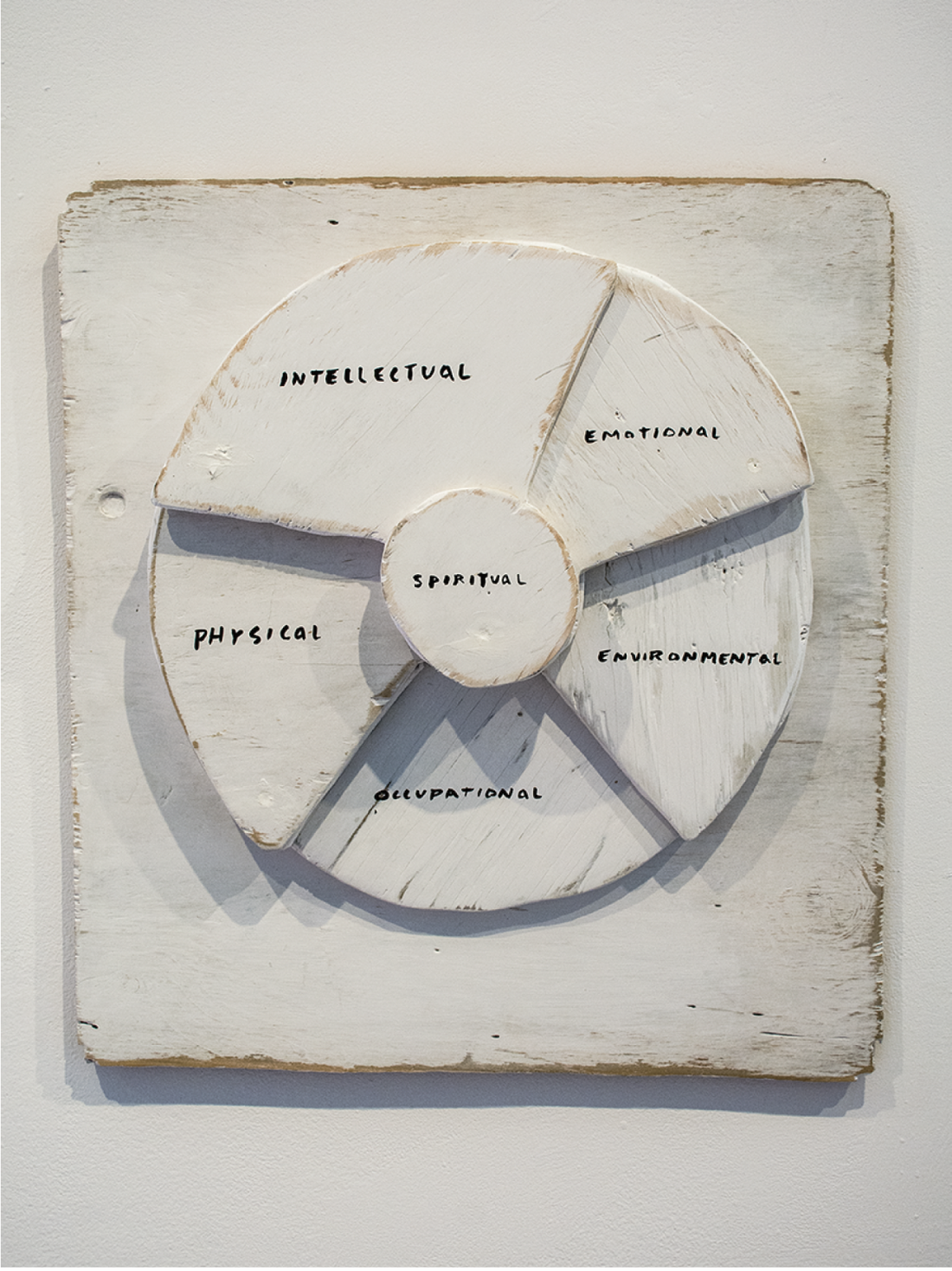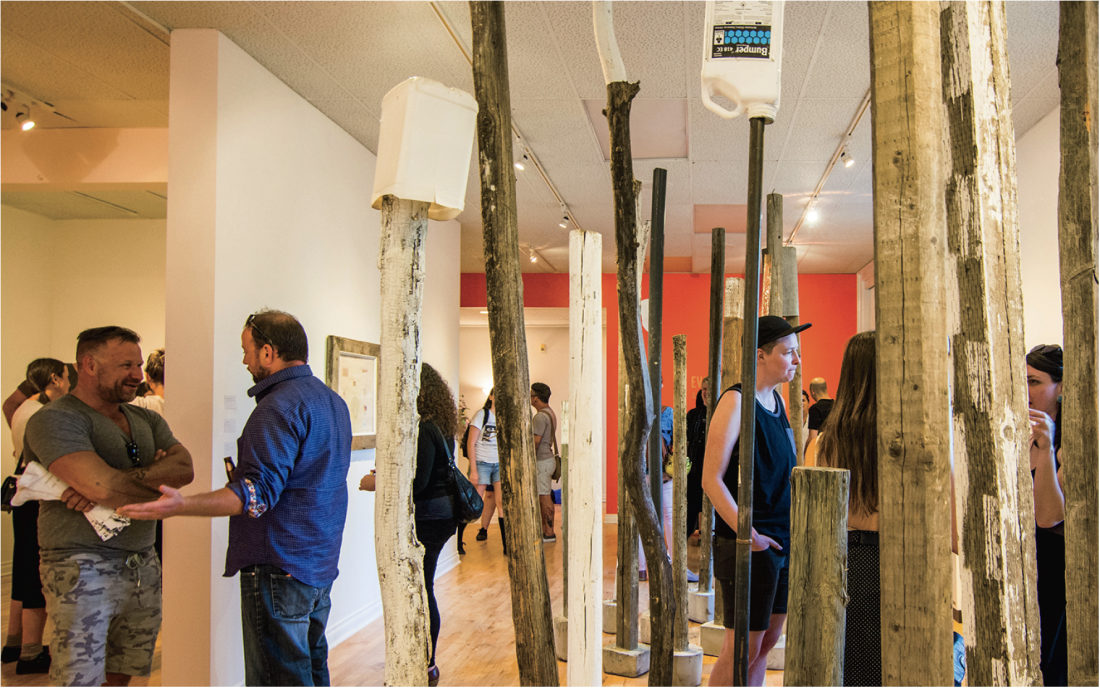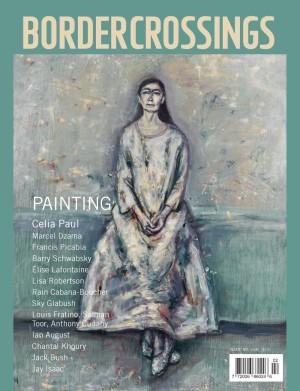Evan Sabourin
Taking in Evan Sabourin’s exhibition “Ailleurs / Elsewhere” is weird and sad and fake and lovely and exuberant and nothing, but it’s also everything. Late in 2015 Evan successfully applied for an exhibition of what was supposed to be a site-specific installation at the not-for-profit space La Maison des artistes visuels francophones. The following spring he overdosed at his home in Saint-Jean Baptiste, leaving the gallery with the uneasy questions of whether to go ahead with the exhibit and, if so, how? Ultimately, Evan’s friends Andrea Oliver Roberts and Gabrielle L’Hirondelle Hill were tasked to curate a survey of the artist’s work that ended up spanning nearly 20 years.
Not the result of formal training, Evan’s art shows influences from life as opposed to the canon. The Wellness Wheel, a sounding stone during the recovery process, is a recurring motif in “Ailleurs / Elsewhere”—used to good effect. When skewed, the words “Intellectual,” “Physical,” “Occupational,” “Environmental,” “Emotional” and “Spiritual” are playfully swapped out for “Actively trying to fulfil the void,” “That thing you do when you’re trying to be ‘Present’ and live in the moment,” “Online,” “Sleep,” “Your work,” “The pursuit of sex,” “Other,” “Fulfilling the void.”

Evan Sabourin, Wellness Wheel, 2015, found wood, acrylic, India ink, 35 x 23.5 x 2.5 inches. All images courtesy of La Maison des artistes visuels francophones.
Among the mixed media works on found pieces of board, paper and canvas, there is an unhappy balance of punk aesthetics and postmortem blues staged in the pristine gallery setting. Evan’s real strength as an artist—or, at least, what he was able to explore the most in his time practising art—can be found in his use of text. (Un) funny jokes that leave you queasy but with a smirk are often scrawled across his surfaces—quips about depression and addiction, about recovery and the addict’s promise of sobriety or even the promise that sobriety carries for the addict. In one drawing, a pair of legs and heavy workboots are positioned atop a pile of papers and books, dated January 1, 2011. The accompanying text reads, “Standing on three years of ‘Hope in the Shadows’ calendars with the days counted and crossed out and not feeling any taller.” This self-deprecating humour comes with abrupt conclusive statements like Untitled (after leaving home), 2014–2016, a piece of rough barnboard and the words, in black paint, “After leaving home, I’d planned to go to art school but I became a homeless junkie instead” taking up most of the surface. Or the similarly treated pieces of wood formed to look like blue tears, each approximately 1 foot high, mounted on a crude cross footing. They respectively read: “It’s not you It’s me” and “It’s you Not me.” In a simple and maybe even elegant work, an untitled black and white square drawing is made to look like the back of a Polaroid with text along the bottom white margin —“VIEW FROM INSIDE THE SENSORY DEPRIVATION TANK.” These glimpses into Evan’s experiences, his unflinching truth and use of sarcasm keep our attention, keep us craning our necks to read the small handwritten stories that wind their way over certain works, keep us on the verge of laughter or tears. For example, this stark image is next to another drawing where he visually considers, à la scales of justice, the word “heroin” and the name “Sarah,” ultimately resulting in the drug’s outweighing the relationship. The immediacy of his materials —likely a side effect of the precariousness of riding the rails and living in punk squats for over a decade— is ever-present. Whether it is his use of collage, drawing, painting, assemblage or zines (all of which are included in this survey), there is something deliberately quick and unselfconscious but completely telling in his work. However, in Evan’s final series, Milemarkers, 2015, a vertical assembly of tree branches and large wood and metal poles individually anchored in concrete that stand about 10 feet high on average, and are adorned with rusted coffee tins, bent nails, pieces of utility hose, red fabric and plastic jugs, we see an exploration of scale that would never have lent itself to his previously nomadic existence. Some poles are painted white, while others are left weathered and untreated. They crookedly angle upward, wobbly but not going anywhere. These pieces of found wood cluster, in opposition to their intended agrarian purpose (to delineate half-mile markings throughout fields), but suggest a second reading linking back to the language of rehab so prevalent in other work, which might allude to a way of finding oneself in (and out of) the mess of place and placelessness.

Evan Sabourin, Milemarkers, 2015, found woods, metals, concrete, found objects, variable dimensions.
Evan Sabourin (1979–2016) was always easy to pick out in a crowd, usually because he was unlike anyone else at that gathering—not just because of the stick and poke tattoos that ran up and down his arms as well as over a good portion of his face. I knew Evan from the small overlapping circles of artistic and queer communities in Winnipeg. We ended up at a lot of the same openings together, and usually the same bars afterwards. His humour was palpable. I remember one opening where he got caught in a summer downpour on the way to the gallery, and in his soaked-through t-shirt, jeans and secondhand loafers, he struck a pose and winked on his way to the washroom to dry off. He later stated that he was finally able to afford new eyeglasses and that he was going to fix his teeth next. I’m not looking to extol the virtues of someone whose life ended because of the addictions he lived with; I don’t want to demonize or valorize the man or our memories of him. I want to talk about his work, and it just so happens that Evan’s work reads like a diary of his drug use, his time tree planting, riding freight trains, loving punk culture, his dalliances in the sex trade, being pissed off at Paul Martin, laughing at the mess he made of his life, and the hope he always managed to find.
How can an exhibition, then, be expected to carry with it the same weight of presence as someone who is no longer there and who, if present, would imbue the space himself? Ultimately, “Ailleurs / Elsewhere,” in all of its success, is not a show of Evan’s work but a show of work made by Evan. ❚
“Ailleurs / Elsewhere” was exhibited at La Maison des artistes visuels francophones, Winnipeg, from July 13 to August 26, 2017.
A writer, curator and artist, Kegan McFadden was recently appointed Executive Director of Victoria’s Open Space artist-run centre.

